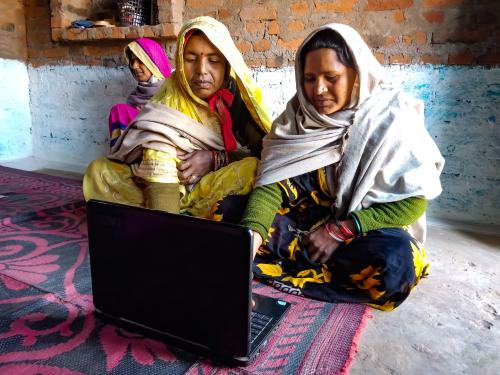Dekleptification (noun): The process of uprooting entrenched kleptocratic structures—USAID
The enhanced USAID focus on corruption is reflected in its release in September of a trilogy of documents on anti-corruption—a draft “USAID Anti-Corruption Strategy”, USAID Guide to Countering Corrupton Across Sectors, and Dekleptification Guide. The latter is particularly interesting and timely.
The Dekleptification Guide is a program guide built on the knowledge and experience of USAID staff involved in anti-corruption programs in 14 USAID missions and compiled under the leadership of an outside policy expert serving an eight-month fellowship at USAID. The result is a compelling, informative, and frank report based on what USAID, other U.S. government agencies, NGOs, and various donors have collectively done over several decades of addressing corruption.
This innovative report is instructive for a broad array of audiences—USAID, development practitioners, in-country partners, policymakers, donors, and investigative journalists.
Program guide
This program guide is a roadmap of how to “dekleptify” through what it identifies as three pillars of reform:
- Transparency—making public information on government officials’ assets, beneficial ownership of companies, and government procurement
- Accountability—putting this information and government spending in forms that are readily available, and supporting civil society and independent law enforcement agencies to hold public officials accountable
- Inclusion—opening the economic space by ending economic capture
The guide identifies three successive phases of political opportunities, or “windows”, to pursue dekleptification—Before the Window, During the Window, and After the Window. It outlines actions to be taken within each stage.
For example, “before the window” is the time to begin deep political/economic analysis and map the kleptocracy and how it functions, invest in civil society, and build relations with indigenous anti-corruption actors.
The guide goes into considerable depth and breadth in laying out actions for “during the window,” including 11 lessons learned and specific actions to be taken to institute the three reform pillars of transparency, accountability, and inclusion. It then identifies several steps to be taken “after the window” in order to support and defend reformers and call out incidents of backsliding.
The map below shows the period the window was, or still is, open in the 14 countries. What stands out is that six of the countries are in the former Soviet Union, with the window still open in four.
Figure 1. Map of USAID missions and dekleptification windows
Source: Dekleptification Guide: Seizing Windows of Opportunity to Dismantle Kleptocracy, U.S. Agency for International Development
Ukraine
The appendix on Ukraine, one of 25 countries out of 180 for which Transparency International reports an improvement in corruption over the past decade, is particularly timely. It draws a comprehensive and detailed picture of a decade of anti-corruption activities in Ukraine by USAID, other U.S. government agencies, donors, and local partners.
Not to downplay actions on dekleptification that still need to be undertaken, but as a striking indication of the progress, among other transparency measures, Ukraine has the world’s:
- First public beneficial ownership registry
- Most transparent public procurement system
- First public database of politically exposed persons
- Most comprehensive and well-enforced asset declaration system
The story of dekleptification in Ukraine is not all roses. A hard lesson is that it is not enough just to secure the creation of anti-corruption governance bodies, but that civil society and reform actors must stay vigilant on how they are set up, staffed, and operated. As oligarchs seek to install their allies and otherwise stymie their operations, three of five specialized anti-corruption agencies lack permanent leadership. But Ukraine has adopted a truly brilliant safeguard system that calls on international expertise and credibility while honoring Ukrainian sovereignty and ownership—Ukrainian law now requires that judicial candidates for the High Anti-Corruption Court (HACC) must first be vetted and approved by the Public Council of International Experts.
Among the positive stories is the adoption of e-procurement. The electronic goods and services procurement system ProZorro (transparency) was established in 2016, with technical support from the Eurasia Foundations and funding from USAID and later UKaid. Through administrative efficiencies, increased competition, harmonization with EU standards, and reduced opportunities for corruption, ProZorro has saved the Ukrainian Government some $6 billion. Its companion DoZorro (watchdog) is a civil society network that uses the open data made available through the ProZorro system to bring accountability to questionable procurements.
This progress in reducing opportunities for corruption should provide donors with a degree of confidence that, once the war is over, there is a foundation on which to rebuild Ukraine without a new cadre of kleptocrats.
Observations
Each reader of the “Dekleptification Guide” will have particular aspects on which to elaborate. Three areas are particularly noteworthy.
Integration/Collaboration—put urgency to making work the U. S. government interagency and collaboration with other donors.
The report highlights that fighting corruption is not just technocratic; it is a highly political endeavor that crosses all sectors of social, economic, and political life. USAID cannot do this alone. It requires coordination of its dekleptification work through the interagency, which we know is an often difficult and frustrating process. It also requires collaboration with other donors, and we know the difficulty of integrating activities of the U.S. government with those of other donors, but we also know that successful execution of dekleptification requires the combined expertise and clout of the international community.
One way to facilitate interagency collaboration is the agency personnel exchange model established by Goldwater and Nichols in 1986 for the U.S. military. The enhanced priority for diplomacy, development anti-corruption work, and interagency collaboration targeted in the administration’s Strategy on Countering Corruption should serve as an incentive to expand the exchange of personnel between the State Department and USAID. For instance, State Department officials might serve a stint with USAID’s newly established anti-corruption task force and USAID staff take their knowledge to State’s anti-corruption work.
Localization—The principle that development does not work without local ownership is widely accepted, but implementation has proved difficult. The Ukrainian model of candidates for judicial positions first vetted and approved by an independent international body of experts is innovative in combining international credibility with local ownership of national entities making the final selection. This can serve as a model in other arenas as well. For example, donor programs can offer a selection of policies, prescriptions, and solutions gleaned from best practices from which local officials and partners can choose what fits best in their environment.
Conditionality received a bad reputation in the 1990s with donor assistance conditioned on tens, even hundreds, of separate conditions, most of which received at best a wink-and-nod from the recipient government (see Stefan Dercon, “Gambling on Development” page 282). But the Ukrainian authors of the “Memo: Ukraine’s anti-corruption theory of change” argue that conditions are necessary and appropriate when the demand is driven by Ukrainian society.
E-government—e-government, or digital government, should be a core foundation of any dekleptification program. It has the unique ability to be offered even before the window of reform opens as it can be presented as a way to make government more effective, more efficient, and more responsive, while downplaying its anti-corruption aspect. Yet it establishes transparency and accountability that can be built upon once the window opens. USAID’s Digital Strategy provides a framework for how to advance digital development. The caution is that digital capabilities are not inherently benign, so donors must avoid sharing digital government capabilities in ways that empower authoritarian regimes.
Conclusion
The “Dekleptification Guide” notes that the opportunity for dekleptification does not appear gradually through a few well-intended political reformers. It comes with a “big bang” when citizens take to the streets. The window of opportunity can be short, so donors need to act quickly. Donors must have already done the spade work of political/economic analysis of where and how corruption takes place and what networks might support reform. They must have the will and means to coordinate and collaborate among themselves and with local actors and be nimble in response to frequently changing dynamics.
USAID is to be commended for producing a playbook that is visionary yet pragmatic as to what can be accomplished and what that will take. The playbook is also assuredly honest about mistakes and setbacks that have and will be confronted.
Addendum: recent reports that are excellent companion pieces to USAID Dekleptification Guide
“Post-Kleptocracy Assessment Framework: Context Analysis and Response Strategies” by National Democratic Institute (forthcoming)
- This publication provides details on how to carry out a political/economic analysis of the lingering kleptocratic networks and the countervailing forces (reformist sectors), along with steps to take and lessons learned.
“The Kleptocrat’s Playbook: A Taxonomy of Localized and Transnational Tactics” by International Republican Institute
- This report reveals how to identify kleptocrats by cataloguing their domestic and transnational tactics and provides a series of strategies to counter those tactics and build resilience among civil society and reformers.
“Memo: Ukraine’s Anti-Corruption Theory of Change: Recipe for success and lessons learned for the windows of opportunity” by Anticorruption Acton Center
- This memo presents the principal elements of the Ukrainian anti-corruption transformation, centered around the three pillars of (1) transparency on who owns what and how government funds are spent, (2) supporting civil society, and (3) establishing independent anti-corruption institutions; it emphasizes engaging international support, including tapping the integrity of international jurisprudence experts.
The Brookings Institution is committed to quality, independence, and impact.
We are supported by a diverse array of funders. In line with our values and policies, each Brookings publication represents the sole views of its author(s).








Commentary
Dekleptification—How USAID has fought corruption in Ukraine and elsewhere
October 6, 2022